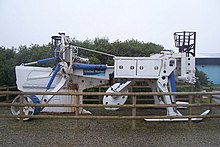
A pipe-and-cable-laying plough or moleplough[1] is a method to bury cables or pipes. The machinery is a form of a subsoiler with a single blade. It is used to lay buried services of virtually any description, for drainage, water, electricity, telecommunications, gas supply etc.. A coil of the service pipe/cable is mounted on the tractor and is led down a guide behind the blade, and is left buried behind the plough in a single operation, without the need to predig a deep trench and re-fill it.
This process is normally used in rural areas where previously buried services will not be encountered and there are no hardened surfaces, e.g. tarmac concrete etc..[citation needed]
There are also specialised laying ploughs for cable laying behind traffic barriers, in stream or lake beds or even for the laying of submarine cables in deep sea, so-called sea ploughs. Sea ploughs are pulled behind cable ships and bury the cable in the sea bed. Burying submarine cables helps protect them from anchors, trawlers and other risks.[citation needed]
One early recorded attempted use by the British was in 1855 during the Crimean War, however the plough was found to be too light for the frozen soil.[2]: 450